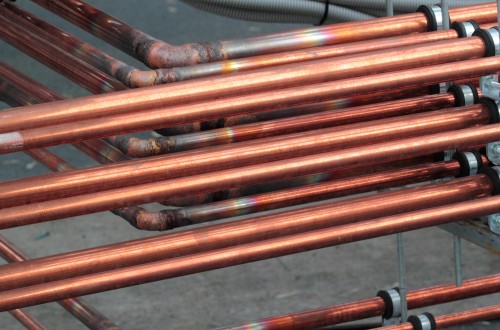 The pipes used throughout your home play an essential part in providing comfort and convenience. They transport gas and water throughout your property, and the materials used to construct these pipes can determine how efficient and durable they are.
The pipes used throughout your home play an essential part in providing comfort and convenience. They transport gas and water throughout your property, and the materials used to construct these pipes can determine how efficient and durable they are.
Amongst plumbers and homeowners alike, copper tubing remains to be one of the most popular solutions for pipe construction. Thanks to a range of natural benefits, such as strength, flexibility, and long-term reliability, copper is the preferred choice in a range of projects, from plumbing to medical development. Approximately 95% of American homes may have some form of copper pipe installed.
So, what makes copper pipe such a great choice?
Copper is Strong and Durable
When you install new pipes in your home, you want them to last for as long as possible. Most plumbers install pipes behind walls, which means that repairing them can be a frustrating experience. Fortunately, copper piping is the only material around the comes with a manufacturer’s warranty of 50 years. That means that homeowners get half a century’s worth of reassurance.
What’s more, copper can hold up well under extreme pressure. In some cases, copper can handle as much as 1,000 pounds’ psi of pressure, and unlike other materials, it can manage regular freezing and thawing (though you should avoid exposing any plumbing to extreme temperatures).
Copper is Versatile
Today, copper can be used in a range of innovative applications for maximizing performance and sustainability. Professionals use copper water pipes throughout new, and older properties, while mechanical systems frequently choose copper for long-term reliability. For instance, copper piping appears in:
- Domestic water distribution and delivery:
- Air conditioning: because copper pipe has excellent thermal performance and superior resistance to corrosion, it’s ideal for refrigeration and ventilation.
- Medical gas: copper piping can deliver essential medical gasses in hospitals thanks to the clean and naturally hygienic nature of the material.
- Fire sprinklers: Copper piping stands up well to extreme heat, which makes it perfect for providing protection against fires.
The unmatched strength, reliability, and versatility of copper makes it suitable for a range of piping solutions, from heating and cooling, to irrigation and water delivery. When longevity counts, most technicians turn to copper.
Economical and Cost-Effective
Although copper can be more expensive to purchase than PEX or PVC, it’s typically less expensive on a long-term basis. The inherent qualities of copper mean that it needs less maintenance and repair, which defines this type of plumbing as a long-term economic investment.
Over time, copper will require less attention from professionals, which means limited expenses and hassles for property owners. What’s more, copper is particularly easy to work with. Copper can be adjusted to various shapes and sizes, and the pipes are simple for plumbers to install. While this might not seem like a direct benefit to you, it’s ease-of-use means that repair and re-piping jobs could be less expensive than you think.
Safe and Reliable
By far one of the most important benefits of copper piping is that this material is non-toxic and capable of delivering pure drinking water. Copper is naturally biostatic and impermeable, which means that it doesn’t absorb any unwanted contaminants. What’s more, the material itself restricts the growth of harmful bacteria.
Because it’s non-combustible, copper won’t carry fire through walls, ceilings or floors in the event of a house fire. In most circumstances, copper piping can withstand significant exposure to fire, as the melting point of the material is 2,000oF.
What to Be Cautious About
Though most experts agree that copper pipes are a highly reliable and durable material — this substance is still vulnerable to problems over time. While proper installation and maintenance can address many of the issues commonly associated with copper pipes, corrosion can sometimes occur in certain environments – such as cold areas or places with acidic water.
What’s more, though copper costs less than some materials, it is a lot more costly than plastic and is not as flexible as PEX tubing. Fortunately, you don’t necessarily have to choose between copper piping or PEX, CPVC, or PVC plumbing for your home. With assistance from a skilled professional, you can always mix your choices up to find the best solution for your home.

 FREE Live Music and Family Fun at Allied Gardens First Fridays The next Allied Gardens First Fridays Summer Concert in the Park is just around the corner. Grab your lawn chairs, bring a picnic, and get ready to meet your
FREE Live Music and Family Fun at Allied Gardens First Fridays The next Allied Gardens First Fridays Summer Concert in the Park is just around the corner. Grab your lawn chairs, bring a picnic, and get ready to meet your  Ideal Plumbing Heating Air Electrical Named Winner of 2023 Better Business Bureau Torch Awards for Ethics in San Diego (San Diego, CA – September 15, 2023) Better Business Bureau Serving the Pacific Southwest (BBB) has named Ideal Plumbing Heating
Ideal Plumbing Heating Air Electrical Named Winner of 2023 Better Business Bureau Torch Awards for Ethics in San Diego (San Diego, CA – September 15, 2023) Better Business Bureau Serving the Pacific Southwest (BBB) has named Ideal Plumbing Heating